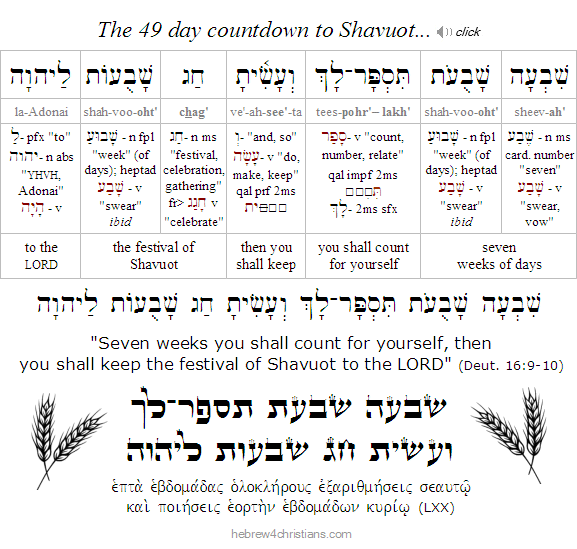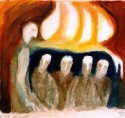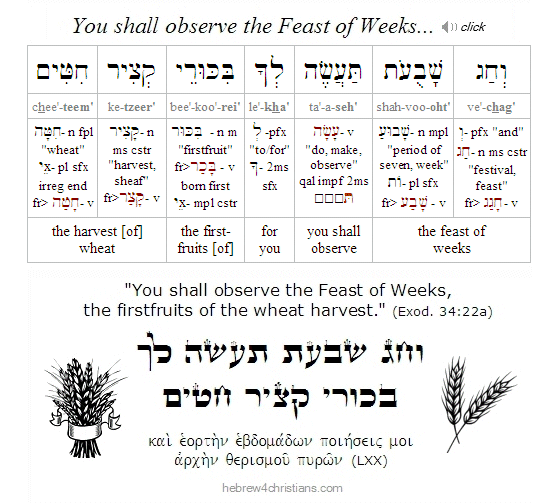|
The holiday of Shavuot (ūŚųĘūÆ ūöųĘū®ūüųĖūæūĢų╝ūóūĢų╣ū¬) is called "Pentecost" in Christian tradition. The Greek word Pentecost (ŽĆ╬Ą╬ĮŽä╬Ę╬║╬┐ŽāŽä╬«) means "the holiday of fifty days" that refers to the 50th day after the crucifixion of Yeshua when the Holy Spirit descended upon the disciples and when Peter first proclaimed the truth of salvation in Jerusalem (Acts 2:1-43). The Torah teaches us that Shavuot is a major biblical holiday (it is one of the three "required festivals" of the LORD, see Exod. 23:14-17; Deut. 16:16) and therefore it behooves us to understand its significance as the climax of Passover itself -- 'the endpoint' of the redemptive experience. Indeed, just as the blood of the lambs smeared on the door posts led directly to the Sinai experience 50 days later, so the crucifixion of Yeshua led directly to the descent of the Holy Spirit to empower His followers to serve God under the new covenant of Zion.
 |
There are two basic priestly rituals commanded for Shavuot: 1) the waving of the two loaves of (new) wheat bread (called Shtei Ha-Lechem: ū®ūüų░ū¬ų╝ųĄūÖ ūöųĘū£ų╝ųČūŚųČūØ), and 2) the offering of korban shelamim (peace sacrifices). Both of these aspects of the priestly avodah (service) were fulfilled in the greater sacrifice of Yeshua made on our behalf. Moreover, just as worshipers at the Temple would present bikkurim (ūæų╝ų┤ūøų╝ūĢų╝ū©ų┤ūÖūØ)- their choicest first fruits - and attest to God's faithfulness before the altar (Deut. 26:3), so we are called to walk in the fruit of the Holy Spirit (ūżų╝ų░ū©ų┤ūÖ ūöųĖū©ūĢų╝ūŚųĘ) and to proclaim the message of God's faithful love for us.
Though it is not explicitly mentioned in the five books of the Torah, the early sages have long associated the giving of the Torah with the holiday of Shavuot. This comes from a careul study of the chronology of the exodus itself, calculating the time of the Passover from Egypt (Nisan 15) to the arrival of the Israelites at Sinai in Sivan 1 (Exod 19:1). The earliest extrabiblical source that explicitly links Shavuot with the revelation of the Torah at Sinai is the Book of Jubilees (i.e., Sefer haYovelim: ūĪūżū© ūöūÖūĢūæū£ūÖūØ), dating from the 2nd century BC. Extant manuscripts of this book were found among the Dead Sea Scrolls, indicating that the Shavuot-Sinai connection was made before the advent of Yeshua. The (non-canonical) book is a parallel account of Genesis and parts of Exodus, and includes the observance of Shavuot by Noah before the time of the Flood. In the Book of Jubilees, Noah is told to observe the festival of Weeks and to offer Firstfruits every year as a commemoration of God's covenant to renew the earth (Jubilees 6:15;22). Likewise Abraham and the original patriarchs were said to observe it, though it was forgotten by the Jews in Egypt until Moses reinstated it at Sinai. Shavuot is also mentioned in the apocryphal Book of Tobit (ūśūĢūæūÖūö) and the Book of Maccabees, c. 2nd century BC.
The Talmud (i.e., traditional oral teaching) also attests to the connection between Shavuot and the giving of the Torah at Sinai. The earliest Talmudic statement on the date of the revelation at Sinai is found in Tractate Shabbat 86b. According to these sages, the Israelites left Egypt on Friday, Nisan 15, and the Torah was given exactly 50 days later on Saturday, Sivan 6th. This corresponds exactly with God's instructions to count 50 days from the day after Passover (Lev. 23:15-16). This date later became fixed in the Jewish calendar, and was further supported by reference to Exodus 19:1: "On the third new moon after the people of Israel had gone out of the land of Egypt, on that day they came into the wilderness of Sinai." (For details about the exact timing for this event, see the main Shavuot article here.) The Midrash Rabbah also explicitly makes the Shavuot-Sinai connection as well. The later rabbis refer to Shavuot as "Atzeret" (ūóų▓ū”ųČū©ųČū¬), a word that means "withdrawal" (i.e., to the desert to receive the law) and "conclusion" (or the goal of the Passover redemption). Today Jewish tradition regards Shavuot as Zman Mattan Torateinu (ū¢ų░ū×ųĖū¤ ū×ųĘū¬ų╝ųĖū¤ ū¬ų╝ūĢų╣ū©ųĖū¬ųĄūĀūĢų╝) - "the anniversary of the giving of the Torah." Shavuot is also called Yom HaKahal (ūÖūĢų╣ūØ ūöųĘū¦ų╝ųĖūöųĖū£) - the "Day of Assembly" (Deut. 18:16).
At the synagogue, it is customary to start the evening Shavuot service later than usual, to ensure that the 50th day has arrived. Many people remain awake for the entire first night of Shavuot reading a special book (tikkun leil Shavuot) that includes the first and last verses of each Torah portion, the first and last passages of each tractate of the Mishnah, and various passages from the Zohar. This book is read to "repair" the night of Shavuot from the error of sleeping so soundly before the Torah was given at Sinai that God had to awaken the Jews with shofar blasts, thunder, and lightning the following morning.
Jewish tradition states that in every generation each person should consider himself as having personally received the Torah at Sinai. The climax of the Shavuot morning service is the recitation of the famous Akdamut poem followed by the reading of Ten Commandments, when all the congregation stands to "relive" the experience at Sinai. A second Torah scroll is then taken out of the ark and the portion is read (Num. 28:26-31) that describes the sacrificial offerings made at the Temple during Shavuot, and the Haftarah (Ezek. 1:1-28; 3:12) concerns the amazing revelation of God in the form of the Throne/Chariot.
The Scroll of Ruth (ū×ūÆūÖū£ū¬ ū©ūĢū¬) - a beautiful story about God's redemptive love - is read on the second day of Shavuot. As the Goel (kinsman-redeemer), Boaz was a wealthy man of the tribe of Judah (Bethlehem) who married a Gentile bride. Boaz's name means "in Him is strength," a picture of the Mashiach Yeshua, his greater Descendant, who also redeemed for himself a bride from among the nations. Among traditional Jews, the Book of Ruth is is read since the events recounted took place during the time of the spring harvest (linking it to the agricultural aspect of Shavuot), and Ruth is a picture of willing acceptance of a Jewish lifestyle (linking it to the events of Sinai).
Paradoxically, the conversion of Ruth was actually against the law given in the Torah itself! According to the Torah (Deut. 23:3), an Ammonite (or Moabite) cannot enter into the family of Israel, and therefore the question arose regarding how Ruth was accepted. Indeed, not only was Ruth accepted, she became the great grandmother of King David through whom the Messiah Yeshua would come (Ruth 4:17).

Shavuot is often portrayed metaphorically as a marriage ceremony between God and the children of Israel. The LORD is the Heavenly chatan (groom) who said, "Accept Me"; the Jewish people represent the beloved kallah (bride); and the Torah represents the ketubah (marriage contract). In some Sephardic traditions, a ketubah is literally read under the traditional chuppah, or wedding canopy, that is set up in the synagogue. Some of the sages note that the idea of marriage comes from the resemblance of the word Shavuot with the word shevuot (oaths). On Shavuot two oaths were taken. One was from God who pledged that He would not exchange the children of Israel for another people, and the other was from the Jews who pledged they would not exchange God for another deity...
This is analogous to the wedding cup that Yeshua offered us in the upper room, before His crucifixion. The Holy Spirit was given to escort us into the heavenly bridal chamber... Collectively, the followers of the Messiah are called Kallat Mashiach - the Bride of Messiah (Rev 21:2,9), and we eagerly await the marriage supper to come (Rev 19:9).
Shavuot marks the time when God entered into covenant with the Jewish nation. During the first Shavuot at Sinai, God instituted the Mosaic covenant and gave the Torah in written form, but during the Shavuot at Zion, after the resurrection of Yeshua, God established the New Covenant when He wrote the Torah on the hearts of Yeshua's followers.
- Shavuot at Mount Sinai is sometimes considered the day on which Judaism was born. Shavuot in Jerusalem (Mount Zion) is the day on which the church was born when the Holy Spirit was poured out upon the followers of the Mashiach.
- Just as the resurrection of Yeshua represents the Firstfruits of those who have died (1 Cor. 15:20) and fulfills the prophetic ritual of the waving of the omer on the festival of First Fruits, so the giving of the Holy Spirit to the followers of Yeshua fulfills the wave offering of the leavened wheat loaves on the day of Shavuot.
- At Mount Sinai the Ten Commandments were written on tablets of stone by the "finger of God" (Exod. 31:18), but at Mount Zion, the Torah is written on tables of the heart by the Spirit of God (2 Cor. 3:3; Heb. 8:10).
- Just as the Israelites were affirmed as God's chosen people on Shavuot with the giving of the Torah, so the followers of the Messiah are affirmed as God's chosen people at Shavuot after Yeshua's ascension into heaven as the Mediator of a Better Covenant (Hebrews 8:6). The 3,000 that were added to the church that day were firstfruits of the redeemed people of God.
Again, the holiday of Shavuot is one of the shelosh regalim (three pilgrimage festivals) given in the Torah (Exod. 23:14-17; Deut. 16:16) and therefore reveals profound spiritual truth for followers of Yeshua (Luke 24:44; 2 Tim. 3:16). God did not want us to miss the significance of this holiday, since it expresses the freedom and truth of the New Covenant of Zion.
From my family to you: Shavuot Sameach - "Happy Shavuot!" May this be a time of renewal and great joy in your lives....
|





